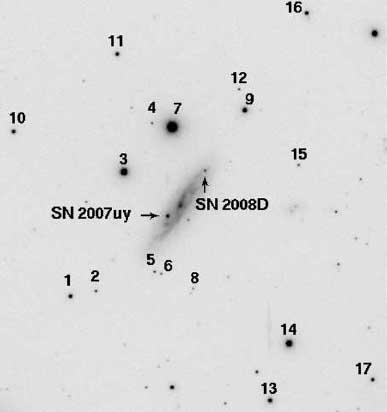
An image of the galaxy NGC 2770, showing the location of supernova 2008D (as well as an earlier supernovae, 2007uy, along with stars in the field numbered to help locate the supernovae precisely). Astronomers have modeled this explosion as originating in a massive star with a comparatively rare, small outer envelope.
Supernovae, the explosive deaths of massive stars, disburse into space all of the chemical elements that were spawned inside the progenitor stars. Furthermore, these violent explosions themselves generate most of the elements above iron in the periodic table, and scatter them as well. Chemical enrichment alone makes supernovae immensely important contributors to the cosmic ecosystem. One class of supernova (type Ia) provide yet another asset: they are thought to be "standard candles," and are used by astronomers to estimate the distances to remote galaxies whose supernovae appear faint because they are far away, thus helping to calibrate the cosmic distance scale.
Because of the importance of supernovae, astronomers want to understand in detail all the pathways by which stars erupt. The peak of the explosions, however, typically last only a matter of days. Unless astronomers are quick to identify and measure the rapidly changing properties of a supernova, the star will fade away and the mechanisms that made it bright will quickly dissipate.
Writing in the latest issue of The Astrophysical Journal, ten CfA astronomers led by Maryam Modjaz (a recent graduate student at CfA and now a Miller Fellow at U.C. Berkeley) and a large team of colleagues report on extensive observations of a recent supernova observed at wavelengths from the X-rays through the infrared. The cataclysm was serendipitously spotted shortly after it began by the Swift satellite, a mission specifically designed to look for energetic, transient events; the mission had already been studying another supernova in the same galaxy. The discovery enabled the team to start collecting data five hours before the first transient X-rays could be detected, and well before the luminosity peaked; they continued to monitor it closely for another 150 days.
The team's relatively complete set of data enabled them to diagnose the nature of the supernova. It began as a massive star characterized by having only a small outer envelope. This type of supernova is comparatively rare, and previous observations of the class had only modest information about its earliest stages of evolution. The new results enable the astronomers to estimate the size of the progenitor star, asymmetries in the outflow, and other details that add to our understanding of these critical cosmic phenomena.